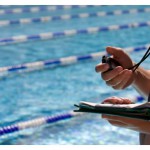 Nearly every swim team requires parents to help out. One of the most common positions is being a timer at a meet. Some people think the position is too stressful, but honestly it is as easy paying attention to the meet and pressing a button for each race. Okay it is slightly more complicated than that, but honestly if you can pay attention and press buttons you can learn to time a meet in just a few minutes.
Nearly every swim team requires parents to help out. One of the most common positions is being a timer at a meet. Some people think the position is too stressful, but honestly it is as easy paying attention to the meet and pressing a button for each race. Okay it is slightly more complicated than that, but honestly if you can pay attention and press buttons you can learn to time a meet in just a few minutes.
Timers Meeting:
Before every meet there will be a timer’s meeting, usually during warm-ups. At the meeting an official, meet director, or someone else in authority will go over what is expected of you. Be sure to show up, pay attention and ask any questions you might have. You will also be given your lane assignment and tools (stop watches, clip board, timers sheets or cards, and pen/pencil). Check your stop watch at the meeting. Make sure it is working and make sure you understand how to operate it. Some watches work differently than others.
Where will you be?
 At most meets each lane will have 2 timers. If there is an electronic timing system usually each timer will hold a plunger (a button connected to the timing system) and a stop watch. With your stop watch and plunger one timer will be on each side of the starting block. At bigger meets, sometimes there are chairs that you are supposed to sit in behind the blocks at the start of each race and you only get up and approach the pool at the end of the race. At lower end meets with younger kids you’ll also be in charge of helping to make sure the kids are getting on the block at the right time. More on that later.
At most meets each lane will have 2 timers. If there is an electronic timing system usually each timer will hold a plunger (a button connected to the timing system) and a stop watch. With your stop watch and plunger one timer will be on each side of the starting block. At bigger meets, sometimes there are chairs that you are supposed to sit in behind the blocks at the start of each race and you only get up and approach the pool at the end of the race. At lower end meets with younger kids you’ll also be in charge of helping to make sure the kids are getting on the block at the right time. More on that later.
What should you do?
- For age group meets you’ll need to make sure the swimmer getting ready to swim matches who you have on your timer’s sheet. Pro-tip, do not ask them if their name is (fill in the blank). Rather ask them what their name is. With little kids you could ask Grace if her name is Bob, and she is likely to say yes, just because she is nervous and will agree with whatever you say.
- The kids will get on the block. The starter will tell them to take their mark then start the race. This is when you start your watch. You do not need to press your plunger button at this time, the timing system starts it automatically.
- Make sure you know the length of your swimmer’s race (it will tell you on your timer’s sheet) and how many laps they will do. If it is short course 25s are one length, 50s are 2 lengths, 100s are 4 lengths, 200s are 8 lengths etc… Long Course the number of lengths are half of the above because it is a 50 meter pool.
- When the swimmer in your lane is ready to complete his/her final length get ready to press both your stop watch and plunger button (if you have one). Press the buttons when any part of their body touches the wall…hand, head, shoulder etc… it is not your job to determine if the finish is legal you are just concerned with the timing of the finish. The officials will determine if it was legal.
- On your timers sheet record the times on both watches on the lines provided. Be sure to write ALL of the numbers on your watch. I ran a meet once where times wrote down things like 26 seconds….26-WHAT?? There is a huge difference between a 26.00 and a 26.96, the tenths and hundredths are extremely important in swimming.
- Continue this process for each race.
Timer FAQs:
What if the 2 watch times in the same lane don’t match? Most of the time they will not, don’t worry just write down what your watches say.
What if I miss the start of a race?
That is what the back-up timers are for! Raise your hand and they will switch watches with you so you have one which was started properly to finish the race with.
What if I need a break?
Again, that is what back-up timers are for. Just don’t wander off too long.
Why do we need to time if there is an electronic timing system?
Timing systems sometimes fail, especially with little kids. If they don’t touch the pad hard enough it won’t record. Or sometimes there are other mechanical issues. When these things happen the admin official or scorer will first use the plunger times (these plunger times often alert them to the problem). If the plungers fail then they go to stop watch times. I’ve been at big important meets where they had to go to the stop watch times…so yes you are important!!!
If you use stop watches which watch does the scorer use?
If watches or plunger times are used they will be averaged together to give the final time.
What if the wrong kid is in my lane?
Do your best to try and correct it by finding the correct swimmer behind your block. If there continues to be confusion quickly get the attention of the starter. If the wrong kids swims in your lane anyway, time as usual and write down their name on the timers sheet and let the scorers and officials figure of the rest.
While it may sound complicated being a timer is really not that hard and it is a always greatly appreciated by everyone involved.
Like us on Facebook
Follow us on Twitter @Swim_Team_101


